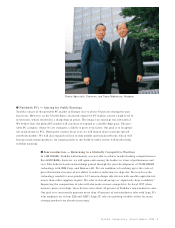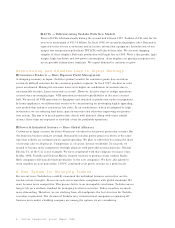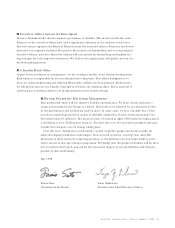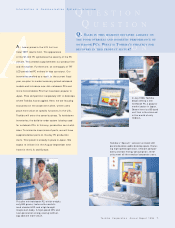Toshiba 1998 Annual Report Download - page 13
Download and view the complete annual report
Please find page 13 of the 1998 Toshiba annual report below. You can navigate through the pages in the report by either clicking on the pages listed below, or by using the keyword search tool below to find specific information within the annual report.
Toshiba Corporation Annual Report 1998 11.
ANSWERS
A NSWERS
ANSWERS
A NSWERS
ANSWERS
A.Q U E S T I O N
Q.
A. Success in DRAMs hinges on two elements:
high performance and low costs. This is why
Toshiba is moving forward with shrinking chips.
Q. FISCAL 1997’S DECLINE IN 16M DRAM
PRICES BROUGHT DOWN THE SALES OF MEMORY
DEVICES. WHAT IS THE OUTLOOK FOR 64M DRAMS?
In October 1997, we were the first to begin mass production with
a 0.25-micron design rule. While our competitors still had chip
sizes of at least 100mm2, we were offering customers 79.4mm2
chips, the world’s smallest. Toshiba’s proprietary trench structure
is also a decisive cost advantage. This technology produces wafers
with an extremely smooth surface. More advances in smoothness
were added to allow raising photoresist sensitivity. So the trench
method makes it possible to use finer processes without a major
technological breakthrough. We are confident that this tech-
nology can be used with 0.15-micron lines. In addition, trench
structrure is ideal for memory-embedded system LSIs, where
demand is rising. We plan to complete the shift of all 64M DRAM
processes to 0.25 microns in the summer of 1998. By the end of
this year, we will start mass production using 0.2-micron pro-
cesses. These advances will keep us at the vanguard of the 64M
DRAM marketplace.
Q. WITH SALES OF SYSTEM LSIS CLIMBING
SHARPLY, WHAT SPECIFIC MARKET SECTORS IS
TOSHIBA STRESSING?
A. Semiconductor demand is gravitating from chip sets for PCs to net-
work equipment, set-top boxes and other multimedia equipment. Toshiba
has combined various IP (intellectual property) cores, or functional blocks,
to offer a range of system support. Portable terminals, image processing,
CD-ROM and DVD storage devices and network equipment are a few
applications. Our goal is to raise system LSI and logic IC sales to a constant
40 percent of our semiconductor business. In CD-ROM chip sets, our market
share is already about 60 percent. Toshiba also leads in system LSIs that
This “ dRAMASIC,” memory-
embedded device was made
possible by Toshiba’s original
trench structure technology.
Sales are rising for use in LCD
modules and other applications.
Toshiba’s cutting-edge second clean room at
the Yokkaichi Works started production in
July 1997. The facility is equipped for design
rules from 0.35 to 0.15 microns.
Electronic Devices & Materials—Interview
Toshiba Corporation Annual Report 1998 11.
























